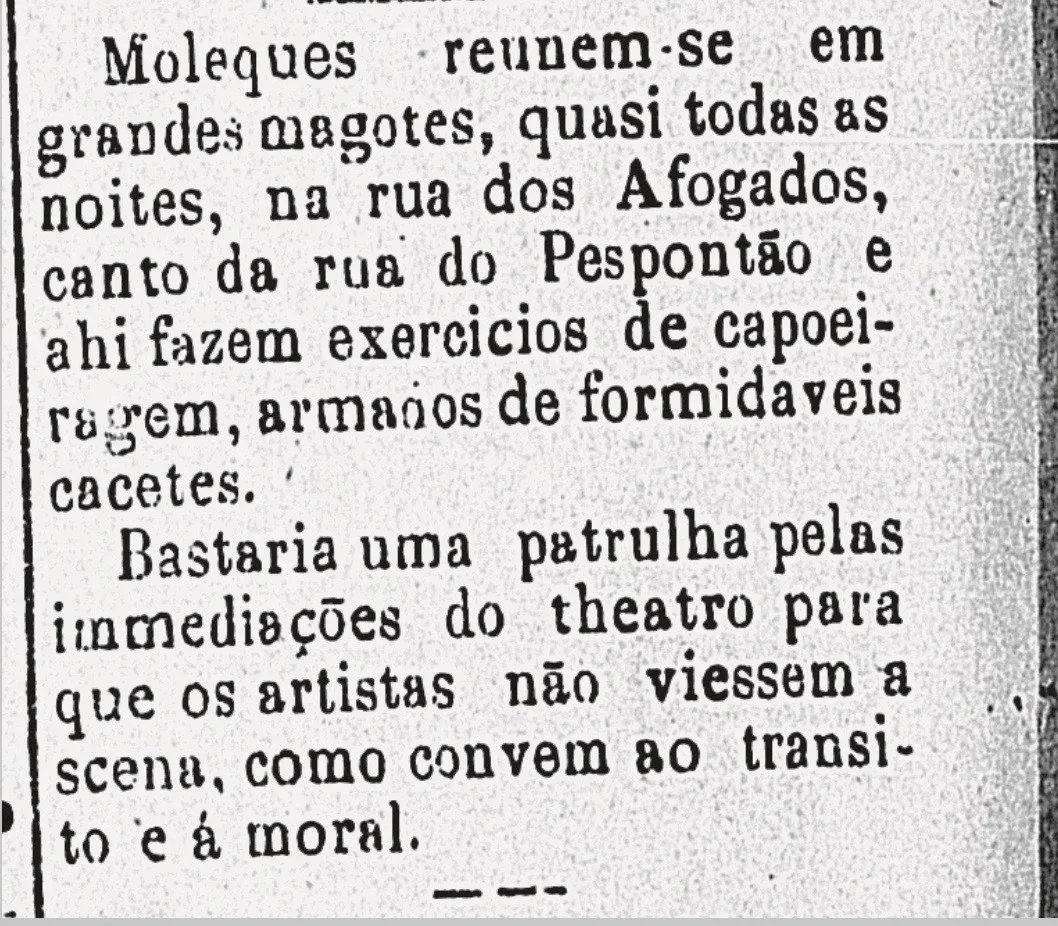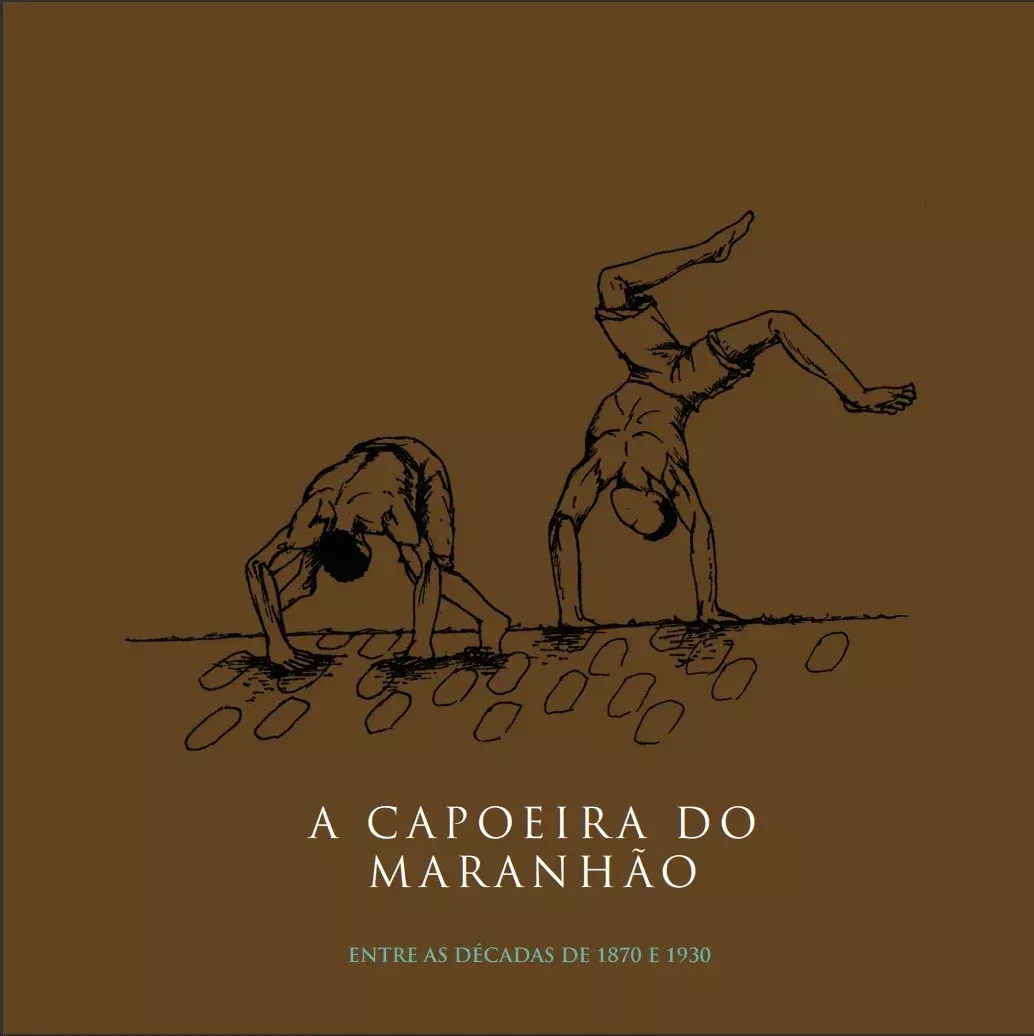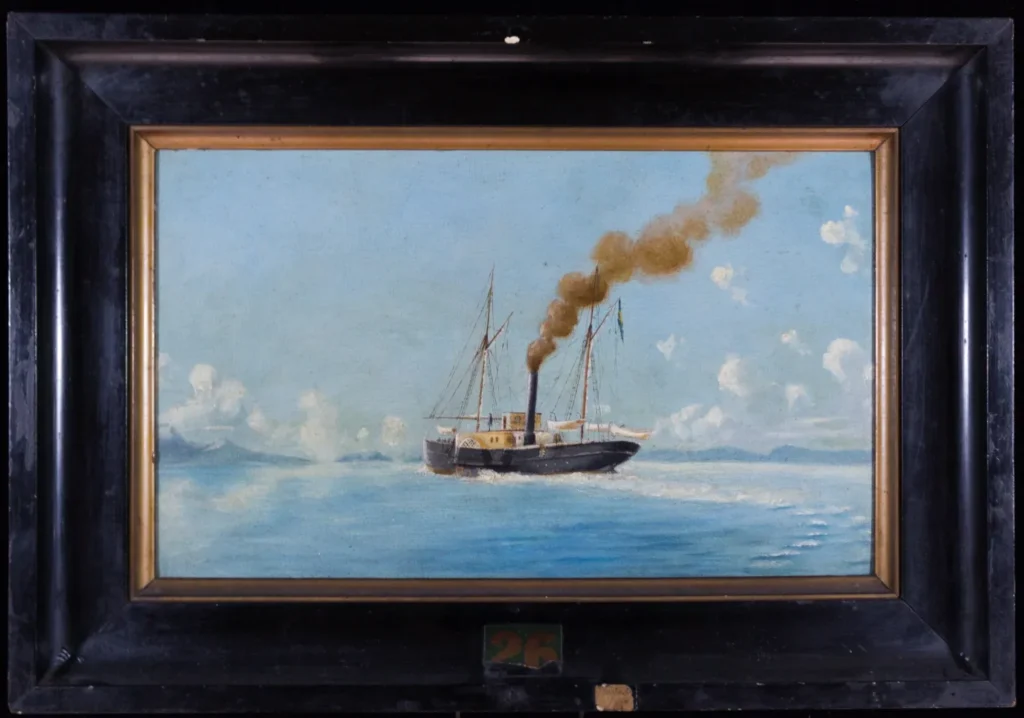By Roberto Pereira.
When the gunboat Lamego, of the Brazilian Navy, left São Luís, on 18th June 1887, the city breathed a sigh of relief. The ship, which had come from Rio de Janeiro eight years earlier to protect the seas of the province of Maranhão, had not brought with it the promised peace. It was in fact a “Greek gift”, a “Trojan horse”. Among its crew, called “Lamegos”, there was nothing less than an entire capoeira gang.
The old federal capital, at the time, was teeming with capoeiragem through every pore, alley, and street. The Jornal do Commercio from Rio de Janeiro registered the performance of these capoeiras who left their mark on several port cities where they passed, on 3 December 1875 as follows:
Yesterday, at 4 o’clock in the afternoon, as the guard of honour was returning to the Acclamation Field, a stoker from the Lamego gunboat, who was marching in a band of capoeiras in front of the music band, stabbed Alexandre Fernandes, commonly known by the nickname of Antonio Monkey.”
Ships, as Peter Linebaugh and Marcus Rediker (2008) state, were breeding grounds for rebels and a meeting place for various traditions. On their boards not only goods and people circulated, but also various street cultures, such as capoeiragem.
During the years they remained stationed on the Black island of São Luís, the behaviour of these “Lamegos” was no different from that in Rio. In a short time, they managed to build a very bad reputation as troublemakers and enemies of public tranquillity – something that rejoiced the capoeiras -, and were feared in the various parishes of the city. One of their legacies was to add another synonym to the word capoeira: Lamego.
The previous capoeira in São Luís
However, capoeiragem in São Luís was not something new. When the imperial marines anchored their ship at the Cais da Sagração and went up the Campos Melo ramp towards the taverns of Praia Grande, São Pantaleão and Desterro, they found on their way a jovial and vigorous capoeira. The discovery, who knows, reminded them of home. These gangs of kids “of all colours” ran through the city, like a sea, with stones and clubs in hand, causing tumult and disorder. They were threatening people and causing panic, especially among the elites, and giving a lot of trouble to the “maintainers” of public order.
It wasn’t just two or three kids – enslaved, free or freed – who left their daily chores and crossed the narrow and dirty streets of São Luís causing a stir or who lingered in the corners, at night, performing “capoeiragem exercises” with impunity. They were, according to the sources of the time, dozens and even hundreds of young people of different ages, including girls:
The newspapers always referred to them collectively as “maltas”[gangs], “battalions”, “hundreds”. To give us an approximate idea, the Diário do Maranhão of 25 April 1876, in a lengthy notice entitled “The moleques making the law”, denounced the presence “in the Laranjeiras estate” of “a gang of some three hundred moleques [street kids] jumping and howling like desperate people, hurling insults and the greatest obscenities imaginable, and their main target were the passengers of the three trams […] (Pereira, 2019, p. 25).
For many years, these gangs of moleques and capoeiras dominated the streets of São Luís, along with a wave of “heroes”, as the press commonly nicknamed them: women “pretending to be tough”, sailors, ” tough guys”, ” troublemakers”. They were certainly one of the biggest headaches for elites in the last decades of the 19th century. Until they disappeared, at least in the sources, in the first years of the new century.

Newspapers at the time often reported about gangs of kids practicing capoeira
Clipping from Pacotilha - Jornal da Tarde, n. 21. Published in Maranhão, on 01/23/1884. Source: Newspaper Archives of the National Library.
Similarly to what happened in Rio de Janeiro or Belém, Pará, the capoeiras of Maranhão were habitués of the ports, docks, taverns, bohemian and working environments; they used knives, stones, cudgels and jack-knives, as well as skilful kicks, headbutts and “stingray tails”(capoeira attack) to resolve everyday disagreements; they left their traces for posterity through police records, lawsuits, and many complaints published in newspaper reports at the request of people from “good families”.
Documentary evidence and recent studies confirm São Luís, in Maranhão, as one of the cities in which capoeira flourished, as historians Carlos Eugênio L. Soares and Matthias Assunção have already indicated. The circulation of people in boats, and in particular sailors, coming from areas further north (Belém, Manaus, etc.) and south (Recife, Rio, Santos, etc.), provided the exchange between diverse capoeiragems, as the case of the Lamegos demonstrates. The presence of gangs of moleques and capoeiras, on the island of Maranhão, shows in turn that this practice was not restricted to the former federal capital. The existence of capoeiras among the “quadrilhas de moleques” of Salvador, as the eminent capoeira researcher Frede Abreu had pointed out, reinforces this thesis.
Women in capoeira in São Luís
In the newspapers of the time, they often figured as responsible for many of the daily “disorders” that were raging in the cities. […] Women who in acts of self-defence used gestures and blows from men’s fights – capoeira – with whom they could be intimate”. (Abreu, 2005, p. 156, apud Pereira, p.76).
The decline of capoeira in São Luís
The case of capoeira from Maranhão is perhaps useful in comparative terms to try to understand the disappearance of the various street capoeiras that flourished all over Brazil until the first decades of the 20th century. From a practice with more collective characteristics until the end of the 19th century, capoeira in São Luís, it seems, in the face of the legal framework and the repression against vagrants and capoeiras at national and local level, was in decline then.
Moreover, as in almost the whole country, capoeira from Maranhão did not adapt to the new times, translating itself into the form of sport or spectacle, climbing into rings, stages, theatres, starring in cinema and on TV. The agents of its modernisation – as did Bimba, Pastinha and others in Bahia – failed to meet it. Consequently, our capoeira has not modernised,
[…] it remained from the mid-nineteenth century until the first decades of the last century as a street practice, eminently male, with a small participation of women, which generally emerged in the environments frequented by the black and poor majority: the popular neighbourhoods, with their taverns, parties, fountains, beaches, etc. as well as the port region of the city (Idem, 2019, p. 118).
In view of this, towards the end of the 1930s, complaints against the uncomfortable presence of capoeiras disappeared from the police pages of the daily press, as did reports of their adventures in the streets of Norte, São Pantaleão, Madre Deus and surroundings. The era of sailors, moleques and “heroes” had come to an end.

A capoeira do Maranhão: entre as décadas de 1870 e 1930
Enjoy and read Roberto Pereira's book in full, edited by the Institute of Historic and Artistic Heritage of Maranhão, in 2019.
Roberto Pereira is a documentary filmmaker, capoeirista and holds a PhD in Comparative History from the Federal University of Rio de Janeiro (UFRJ). He directed and scripted O Dono da Capoeira (2014); Do Ringue aos Palcos and O Jogo da Navalha (2023). He was a doctoral trainee at Harvard University’s Department of History. He is author of the books: A capoeira do Maranhão: entre as décadas de 1870 e 1930. São Luís: IPHAN-MA, 2019 and Rodas Negras: capoeira, samba, teatro e identidade nacional (1930 – 1960); prefácio, Flávio Gomes, 1a. ed. – São Paulo, Perspectiva, 2023.

References
ABREU, Frederico José de. Capoeiras – Bahia, séc XIX: imaginário e documentação. Salvador: Instituto Jair Moura, 2005. v. 1.
ASSUNÇÃO, Mathias Röhrig. Capoeira. The history of an Afro-brazilian martial art. Routledge: London, 2005.
LINEBAUGH, Peter; REDIKER, Marcus. A hidra de muitas cabeças – marinheiros, escravos e plebeus e a história oculta do Atlântico revolucionário. Tradução de Berilo Vargas. São Paulo: Companhia das Letras, 2008.
PEREIRA, Roberto Augusto. A capoeira do Maranhão: entre as décadas de 1870 e 1930. São Luís: IPHAN-MA, 2019.
SOARES, Carlos Eugênio Líbano. A negregada instituição: os capoeiras no Rio de Janeiro 1850-1890. 1993. 451f. Dissertação (Mestrado em História) – Universidade Estadual de Campinas, Campinas, 1993.
______. A capoeira escrava e outras tradições rebeldes no Rio de Janeiro (1808-1850). 2. ed. Campinas, SP: Editora da UNICAMP, 2004.




